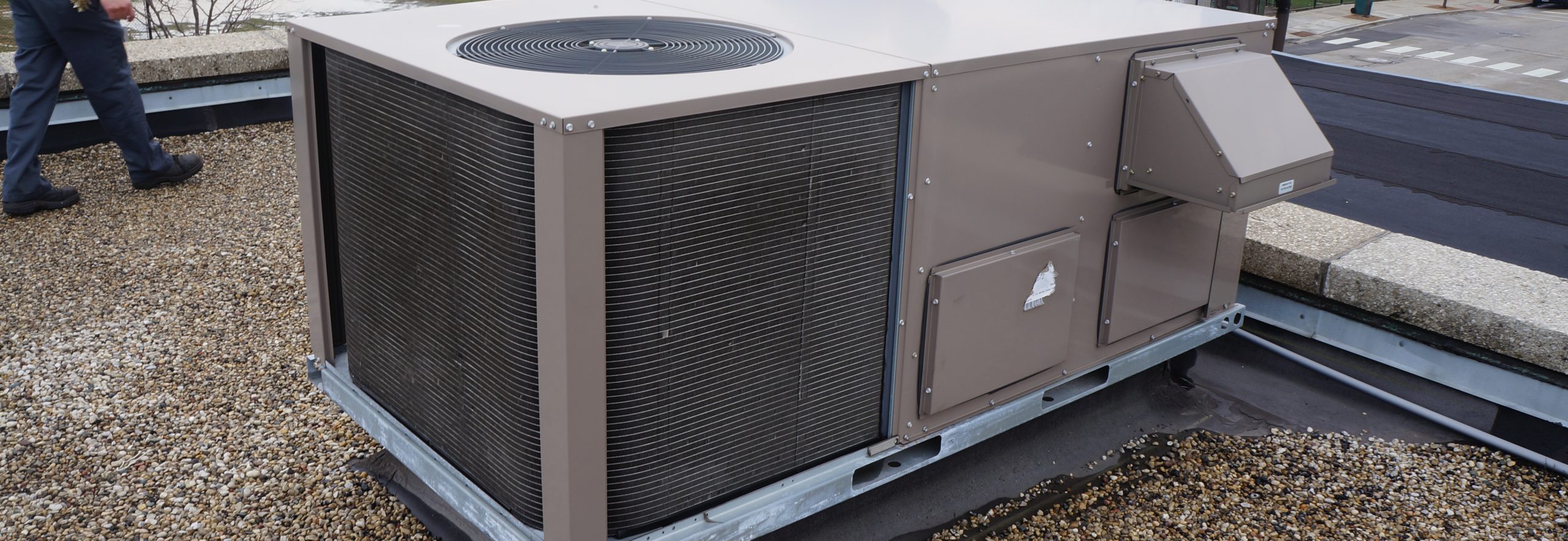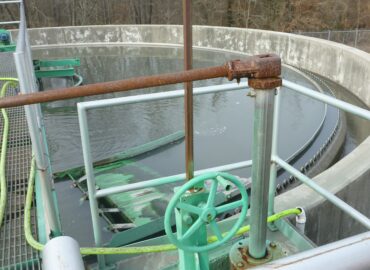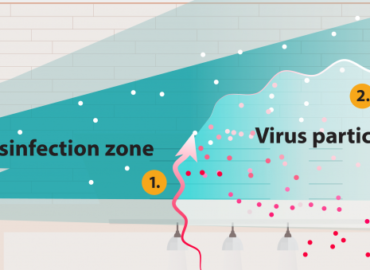What is a condensing unit?
In a split air conditioning system, refrigerant passes through two separate units: a compressor and a condenser. The compressor, typically located outside the building, raises the heat of the refrigerant so it can be rejected by the condensing unit. The condensing unit cools the hot refrigerant before it travels back to the evaporator to start the whole process over again. The condensing unit consists of fins (to disperse heat) attached to coils (where refrigerant flow occurs) and fans (that pass air across the fins and coils, accelerating cooling). The fins are typically thin sheets of aluminum while the coils are typically copper piping.
Why clean condensing units?
Buildup on the cooling fins of a condensing unit keeps air from flowing freely, impeding the efficient transfer of the heat. Depending on vegetation, roadways and industry in the area, a variety of dust and dirt can build up quickly on these critical components of a cooling system.
A blanket of dirt and dust will insulate the coils, preventing heat dispersion and blocking airflow through the fins. This reduces the efficiency of the whole cooling system, makes the compressor run more than would otherwise be necessary, puts additional strain on all components, and, of course, wastes energy and money. Cleaning these components at least once each year is a critical maintenance step and an easy way to reduce emissions and save money, not to mention reduce the change of breakdowns.
In a study published by ASHRAE, a team measured airflow and differential pressure of coils before and after cleaning. The coils were described as being in a "dirty state" after going one year without being cleaned on the 34th floor of a high rise in New York City. The results were impressive:
- Pressure drop across the coil went down 14%
- The cooling capacity in that section of the system increased by 13.6%
- The thermal efficiency of the cooling coil increased by 25% with respect to sensible loads
- The thermal efficiency of the cooling coil increased by 10% with respect to the latent loads
- Air flow across the coils increased 12.5%
How to clean condensing units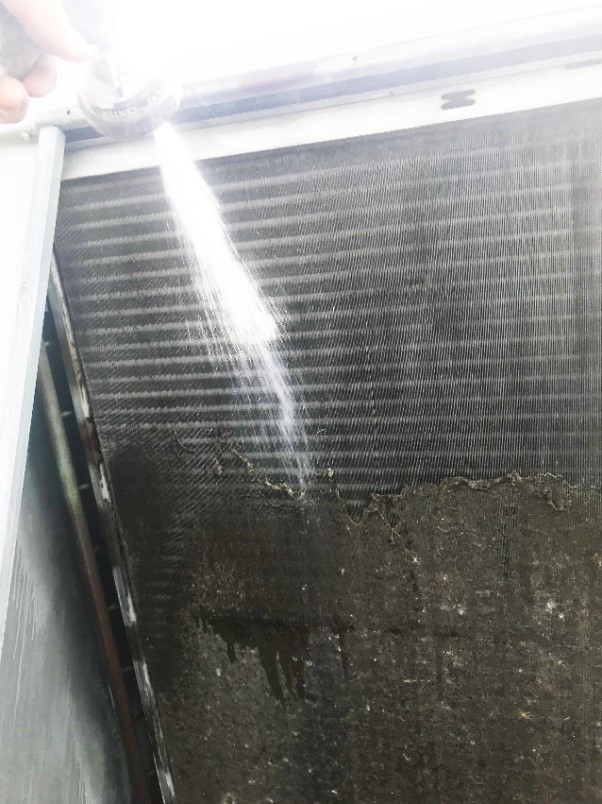
Safety first! Be sure to turn off all electrical connections to the equipment. Lock out or tag all switches to ensure that no one else will turn on the equipment while you are working. Wear appropriate protective equipment for cleaning (gloves and eye protection) and fall protection (OSHA requirements for accessing roof mounted equipment). Protect any sensitive electronic or electrical equipment from potential water exposure.
Accessing the coils can be a challenge. Manufacturers such as Speed Clean sell specialized equipment that enable spray to be aimed inside of traditional residential style condensing units without removing the fan covers and for accessing other specialized equipment. For interior applications, steam machines and special systems have been developed to eliminate messes and clean-up time.
Often, some kind of protective covers will need to be removed to gain access to the fins and refrigerant coils. Always be sure to replace these covers; they are critical to protecting the delicate aluminum fins from permanent damage from bending due to hail or other impact.
Judicious use of a garden hose is often all that is needed to loosen debris. Whenever possible, spray should be directed from the inside of the coil to the outside. Be careful to avoid driving dirt between the fins. If spraying from the inside is not possible, aim down so that water blasts the dirt down and away.
Do not use a conventional pressure washer or other high-pressure spray such as a stream from a garden hose, as these could easily damage fins, permanently reducing airflow. Instead, use a mist or rain setting from a garden hose or watering wand.
When regularly maintained, water should be all that is necessary to clean a condenser. When necessary, mild soap or specialty cleaning chemicals may be used to loosen stubborn debris. Choose only mild soap or the gentlest chemical possible, and follow the manufacturer's instructions for application. Remember the goal is not a bright shiny coil, but one that air (or water) will easily flow through. Clean any residual chemicals from the coil.
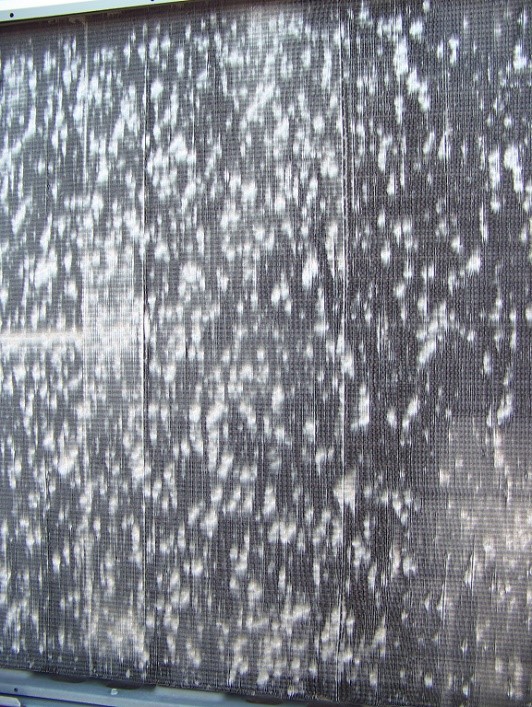 The aluminum cooling fins on condensing units are fragile. As shown in the image to the left, hail (or people) can easily wreak havoc on these sensitive components. Likewise, be gentle when cleaning. Brushes or other tools should be used only when necessary. When fins are bent, air flow is permanently impeded. Fins may be straightened, but care must be used to prevent permanently damaging the fins.
The aluminum cooling fins on condensing units are fragile. As shown in the image to the left, hail (or people) can easily wreak havoc on these sensitive components. Likewise, be gentle when cleaning. Brushes or other tools should be used only when necessary. When fins are bent, air flow is permanently impeded. Fins may be straightened, but care must be used to prevent permanently damaging the fins.


